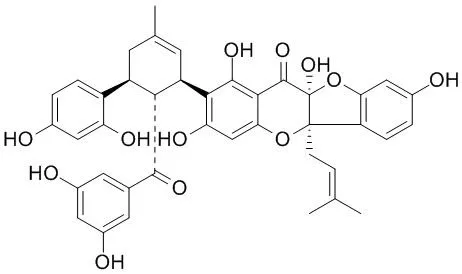| In vitro: |
| J Agric Food Chem. 2006 Nov 1;54(22):8432-6. | | Venturia inaequalis-inhibiting Diels-Alder adducts from Morus root bark.[Pubmed: 17061817 ] | In organic apple orcharding there is a continuous need for natural fungicides effective against Venturia inaequalis (Cooke) Winter, the causal agent of apple scab.
METHODS AND RESULTS:
In this study an in vitro assay is presented for determining the germination inhibitory potential of extracts and pure compounds. From a screening of plant extracts, the methanol extract of Morus root bark revealed distinct V. inaequalis inhibiting qualities, which were subjected to a bioguided fractionation.
CONCLUSIONS:
Among the isolated metabolites [moracins M (1), O/P (2), kuwanon L (3), and Sanggenone D (4), Sanggenone B (5), Sanggenone G (6), Sanggenone O (7), Sanggenone E (8), and Sanggenone C (9)] all the Diels-Alder adducts (3-9) showed an antifungal activity with IC50 values between 10 and 123 microM. The in vitro activity of the most active fraction (A5, IC50 39.0 +/- 4.2 microg/mL) was evaluated in vivo, confirming a distinct antifungal activity against V. inaequalis for the tested natural material. | | Biochem Pharmacol. 2001 Nov 1;62(9):1185-91. | | Effects of naturally occurring prenylated flavonoids on enzymes metabolizing arachidonic acid: cyclooxygenases and lipoxygenases.[Pubmed: 11705451] | Prenylated flavonoids are chemical entities having an isoprenyl, a geranyl, a 1,1-dimethylallyl, and/or a lavandulyl moiety as part of their flavonoid backbone structure.
METHODS AND RESULTS:
In this study, the effects of 19 naturally occurring prenylated flavonoids, isolated from medicinal plants, on cyclooxygenase (COX)-1 and COX-2 and on 5-lipoxygenase (5-LOX) and 12-LOX were investigated using [14C]arachidonic acid as a substrate. The homogenates of bovine platelets and polymorphonuclear leukocytes were used as COX-1, 12-LOX, and 5-LOX enzyme sources; the homogenate of aspirin-pretreated lipopolysaccharide-induced RAW 264.7 cells was used for the COX-2 enzyme source. Among the 19 prenylated flavonoids, morusin, kuwanon C, sanggenone B, Sanggenone D and kazinol B inhibited COX-2 activity (ic(50) = 73-100 microM), but the potencies were far less than that of NS-398 (ic(50) = 2.9 microM). In contrast, many prenylated flavonoids, such as kuraridin, kuwanon C and sophoraisoflavanone A, inhibited COX-1 activity. Of the COX-1 inhibiting prenylated flavonoids, kuraridin, kurarinone, and sophoraflavanone G, all having a C-8 lavandulyl moiety, showed potent activity (ic(50) = 0.1 to 1 microM) comparable to that of indomethacin (ic(50) = 0.7 microM). Most of the prenylated flavonoids tested inhibited 5-LOX activity with ic(50) values ranging from 0.09 to 100 microM. Of these, only kuwanon C, papyriflavonol A and sophoraflavanone G showed inhibitory activity against 12-LOX at low concentration ranges (ic(50) = 19-69 microM) comparable to that of NDGA (ic(50) = 2.6 microM).
CONCLUSIONS:
Our results suggest that the position and the nature of the prenyl substitution greatly influence in vitro biological activities of these molecules. |
|
| In vivo: |
| Planta Med. 2000 Oct;66(7):596-600. | | Effects of prenylated flavonoids and biflavonoids on lipopolysaccharide-induced nitric oxide production from the mouse macrophage cell line RAW 264.7.[Pubmed: 11105561 ] | Certain flavonoid derivatives possess anti-inflammatory activity in vitro and in vivo. Besides their antioxidative properties and effects on the arachidonic acid metabolism including cyclooxygenase/lipoxygenase inhibition, some flavones and flavonols were previously found to show inhibitory activity on nitric oxide production by inducible nitric oxide synthase (iNOS; NOS type 2) through suppression of iNOS induction.
METHODS AND RESULTS:
As part of our continuing investigations, the effects of unique and minor flavonoids (prenylated flavonoids and biflavonoids) on nitric oxide production from lipopolysaccharide-induced macrophage cell line (RAW 264.7) were evaluated in order to establish their inhibitory activity on NO production and correlate this action with their in vivo anti-inflammatory potential. Among the derivatives tested, prenylated compounds including morusin, kuwanon C, and sanggenon D and biflavonoids such as bilobetin and ginkgetin were found to inhibit NO production from lipopolysaccharide (LPS)-induced RAW 264.7 cells at > 10 microM. Inhibition of nitric oxide production was mediated by suppression of iNOS enzyme induction but not by direct inhibition of iNOS enzyme activity. An exception was echinoisoflavanone that inhibited iNOS enzyme activity (IC50 = 83 microM) and suppressed iNOS enzyme induction as well. While most prenylated derivatives showed cytotoxicity to RAW cells at 10-100 microM, all biflavonoids tested were not cytotoxic.
CONCLUSIONS:
Since nitric oxide (NO) produced by inducible NO synthase (iNOS) plays an important role in inflammatory disorders, inhibition of NO production by these flavonoids may contribute, at least in part, to their anti-inflammatory and immunoregulating potential in vivo. |
|






 Cell. 2018 Jan 11;172(1-2):249-261.e12. doi: 10.1016/j.cell.2017.12.019.IF=36.216(2019)
Cell. 2018 Jan 11;172(1-2):249-261.e12. doi: 10.1016/j.cell.2017.12.019.IF=36.216(2019) Cell Metab. 2020 Mar 3;31(3):534-548.e5. doi: 10.1016/j.cmet.2020.01.002.IF=22.415(2019)
Cell Metab. 2020 Mar 3;31(3):534-548.e5. doi: 10.1016/j.cmet.2020.01.002.IF=22.415(2019) Mol Cell. 2017 Nov 16;68(4):673-685.e6. doi: 10.1016/j.molcel.2017.10.022.IF=14.548(2019)
Mol Cell. 2017 Nov 16;68(4):673-685.e6. doi: 10.1016/j.molcel.2017.10.022.IF=14.548(2019)